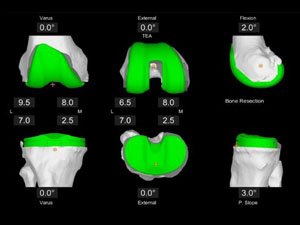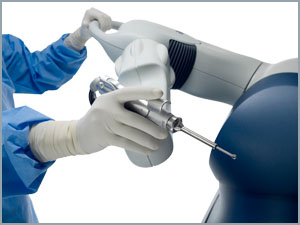If arthritis limits your ability to climb up stairs, take walks or do any of the activities you once enjoyed, then joint replacement surgery may be an option for you.
Grand View Health’s board-certified orthopaedic surgeons perform both traditional joint replacement procedures and robotic-assisted procedures using the Mako® Robotic Arm-Assisted Surgery System.
In a robotic-assisted surgery, our surgeons use a 3-D virtual model of your joint to precisely plan your procedure. They then use the system’s robotic arm during the surgery to remove diseased bone and cartilage and insert an implant.
How Robotic Surgery Works |
|||
| Step 1 – Precise Planning | Step 2 – Personalized Surgery | ||
 |
 |
||
| The process begins with the patient receiving a CT scan of the joint a minimum of two weeks prior to surgery. The robotic surgery system uses this scan to create a 3-D virtual model of your joint that helps identify the size and placement of the implant based on your unique anatomy. | In the operating room, your surgeon will use the robotic system’s computer software to adjust your personalized pre-surgery plan as needed. Then, during surgery, he will guide the robotic arm within the pre-defined area to provide more accurate placement and alignment of your implant. | ||
Use of the robotic system leads to more precise surgery and helps to balance the soft tissues that surround the joint implant. This may lead to less pain and quicker recovery after surgery. All surgery carries risk. Talk with your doctor about whether joint replacement surgery is right for you.
Learn more by reading answers to these frequently asked questions about joint surgery:
You may be a candidate if your pain is caused by arthritis and limits your activities of daily living. Surgery will be recommended only after careful examination and diagnosis of your joint problem, and only after you’ve tried non-surgical options such as exercise, physical therapy and medication.
No one design fits every patient. A surgeon will choose the implant that’s best for you based on your age, activity level, the implant’s track record, and the surgeon’s comfort with that implant.
We perform a type of joint replacement procedure where the worn-out surfaces of your joint are resurfaced with metal and plastic components. This is called a quadricep-sparing technique, and it’s minimally invasive. This technique is designed to reduce or eliminate pain, allow easier movement, and get you back to a normal life.
For patients undergoing a first-time total or partial knee replacement surgery or hip surgery, the team at Upper Bucks Orthopaedics at Grand View Health offers robotic-assisted procedures. Our surgeons use the Mako® Robotic-Arm Assisted Surgery System.
If you are a candidate for robotic-assisted surgery, you will receive a CT scan of your hip or knee two weeks prior to surgery. The robotic surgery system will use this scan to create a 3-D virtual model of your joint that will help identify the size and placement of your implant based on your unique anatomy. In the operating room, your surgeon will use the robotic system’s computer software to adjust your personalized pre-surgery plan as needed. Then, during surgery, he will guide the robotic arm within the pre-defined area to provide more accurate placement and alignment of your implant.
The Joint Center at Grand View Health is dedicated to joint replacement patients. Our local, experienced, board-certified surgeons from Upper Bucks Orthopaedics at Grand View Health will work with specially trained nurses, physical therapists and technicians who will help you get back to your favorite activities as quickly as possible. Our surgeons have earned the Gold Seal of Approval for Total Joint Replacement from The Joint Commission.
Many patients go home after hip or knee replacement surgery the same day as their procedure. Our goal is to help you recover in the comfort of your own home as soon as possible. However, every patient is different, and some patients may need to spend a night or two at the hospital followed by a few days at a rehabilitation center or nursing home after surgery.
Most people will need to use a walker or other device for about two weeks. You may be able to drive within four weeks, and you may get back to favorite activities like golf or bowling in 10 or 12 weeks.
Complications from total joint replacement are rare. Possible complications include blood clots in your leg veins, infection, implant loosening, fractures, nerve or blood vessel damage and stiffness. Your care team will work to minimize the risk of these and any other complications.